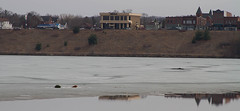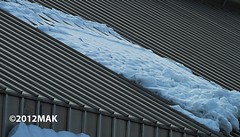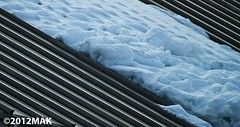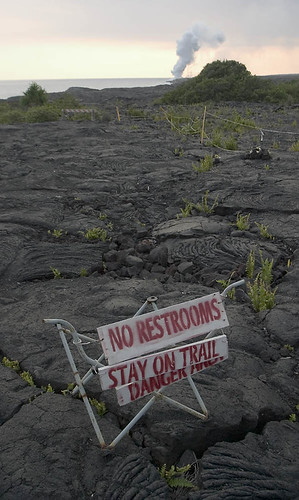Because you can't get enough of wobbly gelatin...
If you aren't moving at a snail's pace, you aren't moving at all. -Iris Murdoch
Friday, March 30, 2012
Thursday, March 29, 2012
Thurs-Demo: The Photoelastic One
Our department has an iPad. It's a lonely first-generation device: it doesn't get as much use as we hoped due to it's limited flexibility with computer projectors and video. Perhaps the newer versions would be more useful. That's not the point of my comment - the polarized light emitted by the iPad is. Last week I was able to use the iPad to view deformation in gelatin. Here's a quick movie of me rotating the iPad in front of my laptop's built in camera. The polarized light from the iPad is extinguished by the polarized filter I have in front of the laptop camera. All you see is a shiny reflection of the computer screen as a result.
My buddy Todd is (hopefully) putting together a post on light and polarization - perhaps he'll include some discussion on the orientation of the polarization of smart phones and sunglasses and such.
So this week, I tried something a little different. I pulled out some circular polarizers and used them to shoot some video of a steel ball dropped onto a dish filled with gelatin. I think the effect is both easier to see and easier to film due to the increased light coming from the setup.
That blue square in the background is one of the circular polarizing filters. There's another one in front of the camera.
The colored bands are a result of interference produced when the gelatin deforms. The spacing of the bands is proportional to the magnitude (amount) of strain/deformation in the material. Here's the experiment with a much larger ball (hence more stress, producing more strain):
For comparison, here's the same experiment in plane-polarized light:
In the write-up above, I've been using stress and strain somewhat interchangeably. That's because the gelatin deforms easily when subjected to pressure. The magnitude of the applied force/area (pressure) is the stress and the amount of deformation is the strain. So when we apply a little stress, we see a small amount of strain. With a lot of stress, a lot more strain develops. But in gelatin, it doesn't take much stress to produce strain. In more rigid solids, stress can develop without any observable strain. But that's a topic for later.
If you like, you could place a square block on the gelatin and see how the stress is distributed beneath and away from the base of the block (much like how stress spreads below and outward from a load placed on soil). Or you could take plaster or food coloring and inject a liquid into the gelatin and see how the shape of the fractures depends on the stress field around the intrusion (Callan has done this and there's a set of neat labs from a prof in Hawaii that talks about this technique in great detail).
I've found that using a gelatin mixture that's about 150% thicker than recommended for "finger jello" works best - and holds up reasonably well to the increased heat of the lights used for filming.
Wednesday, March 28, 2012
Friday, March 23, 2012
Thurs-Demo: The Next One Posted on Friday Because I Was Busy Thursday
This isn't a trend, but I seem to be rather busy on Thursdays. So much so that yesterday's demo didn't happen. Perhaps I'll describe what I was up to at some later point.
Today, however, I took advantage of the light output from an iPad. Many computing devices that have an LCD type screen emit polarized light. It's why I rarely wear sunglasses when I'm out taking pictures - the polarized glasses cut out too much - sometimes all - of the light from the review screen on the back. Wearing polarized sunglasses and looking at a computer can also be tricky.
But stick the iPad behind a transparent, isotropic material and then slap a polarized filter in front of the camera and you have an instant stress-field viewer. I redid the shot of a small cap gun charge through gelatin, but this time the only light was coming from an iPad.
This turned out much better than I had hoped. First, I didn't have a lot of light to work with. Second, many computer screens will produce scan lines because the screen is "refreshing" at some frequency (it's why video of older phosphor screen monitors "flicker"). But the iPad sent out a nice steady light (I made a blank white slide in keynote and just had that as the display).
Now I think I need to get my hands on some of those old fashioned 4"x4" rock thin sections and try photographing them...
Today, however, I took advantage of the light output from an iPad. Many computing devices that have an LCD type screen emit polarized light. It's why I rarely wear sunglasses when I'm out taking pictures - the polarized glasses cut out too much - sometimes all - of the light from the review screen on the back. Wearing polarized sunglasses and looking at a computer can also be tricky.
But stick the iPad behind a transparent, isotropic material and then slap a polarized filter in front of the camera and you have an instant stress-field viewer. I redid the shot of a small cap gun charge through gelatin, but this time the only light was coming from an iPad.
This turned out much better than I had hoped. First, I didn't have a lot of light to work with. Second, many computer screens will produce scan lines because the screen is "refreshing" at some frequency (it's why video of older phosphor screen monitors "flicker"). But the iPad sent out a nice steady light (I made a blank white slide in keynote and just had that as the display).
Now I think I need to get my hands on some of those old fashioned 4"x4" rock thin sections and try photographing them...
Thursday, March 22, 2012
NURD ALURT!
Tuesday, March 20, 2012
Pressure and Shear Waves in Springs
In an experiment fitting the vernal equinox, I was mucking about with springs today. I've been having trouble getting waves to show up well on the high speed camera. The ubiquitous "slinky" behaves a little oddly. Perhaps I'll write about shear waves in slinkys at some point. So I set up a few general springs in hopes of getting a pressure wave (longitudinal wave motion) that travels faster than the shear wave (transverse wave motion).
First run, shot at 1000 fps.
A second run, this time shot at 3000 fps.
Both show the shear (transverse) wave moving at a slower velocity compared to the pressure (longitudinal) wave. One of the methods we have to estimate the location of earthquakes is due to the difference in travel times. Kind of like using the number of seconds between the thunder and the lighting flash to estimate how far away the storm is. The large quake that struck Mexico today was probably located in part by the difference in P- and S-wave travel times.
Now I believe this demo is ready for my intro students...
First run, shot at 1000 fps.
- P-wave travel time: 30/1000ths second
- P-wave velocity: 953 cm/sec
- S-wave travel time: 34/1000ths second
- S-wave velocity: 841 cm/sec
A second run, this time shot at 3000 fps.
- P-wave travel time: 107/3000ths second
- P-wave velocity: 802 cm/sec
- S-wave travel time: 127/3000ths second
- S-wave velocity: 676 cm/sec
Both show the shear (transverse) wave moving at a slower velocity compared to the pressure (longitudinal) wave. One of the methods we have to estimate the location of earthquakes is due to the difference in travel times. Kind of like using the number of seconds between the thunder and the lighting flash to estimate how far away the storm is. The large quake that struck Mexico today was probably located in part by the difference in P- and S-wave travel times.
Now I believe this demo is ready for my intro students...
Monday, March 19, 2012
Caps + Jello + High Speed = Cool
Looking for ways to generate decent shockwaves through gelatin, I managed to produce a good shockwave using standard cap gun charges. Frame rate was too low to really catch the wave propagation, however.
Friday, March 16, 2012
In Praise of the Standing Dead
One of the things that bugs me about most landscaping in urban areas is the sterility. A tree, shrub, grass. Maybe some flowers in a pot or window box. Everything green and growing, but not too fast, not too far or too tall. An example: one of my neighbors graciously offered to cut down a dead aspen that had fallen over and lodged itself in one of the nearby trees. He offered to cut the stump down to the ground and take down the other dead aspen that was right next to it. I kindly refused - standing dead trees are rather useful in a yard (provided they don't threaten to knock over power lines, or fall on your neighbors car). He seemed incredulous and went about his own yard tasks.
Since then, the dead trees have been a den of activity. Both hairy and pileated woodpeckers have been hammering away, digging insects or whatever out of the trunk. They've been covering the ground with coarse woodchips. One of the stumps even has a nesting hole in it (haven't seen anyone using it yet this spring).

Here's a picture of the tree now. I've had woodpeckers all over this thing (about 50% of the tree has been pecked away). I even have a whole mess of woodchips to emphasize the pathway between the perennial beds.
All of this thanks to a dead tree that I left standing. I'd like to think that my neighbor, eager to "clear out the dead wood" understands how much life that dead tree adds to my backyard.
Since then, the dead trees have been a den of activity. Both hairy and pileated woodpeckers have been hammering away, digging insects or whatever out of the trunk. They've been covering the ground with coarse woodchips. One of the stumps even has a nesting hole in it (haven't seen anyone using it yet this spring).

Here's a picture of the tree now. I've had woodpeckers all over this thing (about 50% of the tree has been pecked away). I even have a whole mess of woodchips to emphasize the pathway between the perennial beds.
All of this thanks to a dead tree that I left standing. I'd like to think that my neighbor, eager to "clear out the dead wood" understands how much life that dead tree adds to my backyard.
Thurs-Demo: The One There's Always Room For
So, how do you show students the effects of deformation on various materials? How do you show the accumulation of strain, or the propagation of sound waves through solid rock? You can do it in real time with some polarized filters and gelatin.
Here's a picture of our setup:

We had the bright lights up so we could get some high speed footage. That also meant the gelatin started to melt, so we were limited to about half an hour of shooting.

Here's one of the high-speed shots. I dropped a steel ball onto the gelatin. You can see the "goopy" behavior of the stuff along the top edge as well as the initial deformation followed by the surface waves radiating outward from the impact.
Now for some slicing up with a knife. I like the little "shocks" that radiate outward as I dragged the knife through the stuff.
Finally, here's another ball, dropped onto the cut gelatine. Some interesting additional wave behavior developed.
Those of you who consider yourselves "strain junkies" (yes, I'm making that a term) may be wanting some more detailed information about what's going on from a mechanical perspective. I think my colleague Todd, over at Talking Physics is planning on a more detailed discussion of the mechanics of Jello...
Here's a picture of our setup:

We had the bright lights up so we could get some high speed footage. That also meant the gelatin started to melt, so we were limited to about half an hour of shooting.

Here's one of the high-speed shots. I dropped a steel ball onto the gelatin. You can see the "goopy" behavior of the stuff along the top edge as well as the initial deformation followed by the surface waves radiating outward from the impact.
Now for some slicing up with a knife. I like the little "shocks" that radiate outward as I dragged the knife through the stuff.
Finally, here's another ball, dropped onto the cut gelatine. Some interesting additional wave behavior developed.
Those of you who consider yourselves "strain junkies" (yes, I'm making that a term) may be wanting some more detailed information about what's going on from a mechanical perspective. I think my colleague Todd, over at Talking Physics is planning on a more detailed discussion of the mechanics of Jello...
Thursday, March 15, 2012
Demo-Delayed
I've got most of the video for this week's demo, but it's getting late and I should go to bed. It's been warm here. Really warm. So warm, in fact, that the KLUNKER has fallen through the ice already...
The KLUNKER fell into through the smallish hole in the lower left of the ice (between the two christmas trees)

Here it was just a few weeks ago - you can see the two christmas trees that were placed next to the car.

The KLUNKER fell into through the smallish hole in the lower left of the ice (between the two christmas trees)

Here it was just a few weeks ago - you can see the two christmas trees that were placed next to the car.

Wednesday, March 14, 2012
Gelatin and High Speed Video
You may have seen something like this before - using polarized light to show how a material deforms under stress. I hadn't heard anyone using this technique on gelatin before, so I just had to try it out myself. What a lovely effect. There was som über geekery to be had when we noticed you could easily produce interference patterns. I'll be providing you some more details for tomorrow's demo, but here's a peek into what's going on in the dirt lab:
For all of you strain junkies out there: I'm thinking we are looking at longitudinal strain effects at first - these spread out to a maximum distance quickly and are then overtaken by the transverse surface waves as they radiate outward. Lockwood (Outside the Interzone) mentioned that he had disabled embedded video to reduce computer issues he was having, so here's a still from one of the experiments - this way even those without video capabilities can see what's going on.

For all of you strain junkies out there: I'm thinking we are looking at longitudinal strain effects at first - these spread out to a maximum distance quickly and are then overtaken by the transverse surface waves as they radiate outward. Lockwood (Outside the Interzone) mentioned that he had disabled embedded video to reduce computer issues he was having, so here's a still from one of the experiments - this way even those without video capabilities can see what's going on.

Friday, March 09, 2012
Thurs-Demo: Well here's your problem...

I was trying to make large borax crystals for a lab/demo involving crystallization. What I ended up doing was cracking a 1000mL beaker. Not because of temperature extremes. I think it cracked because the borax crystals were pushing on the sides of the beaker as they formed (out of saturated solution). Oops. Now I have a slight mess to clean up because there was probably another 500mL of water that ended up leaking out of the cracked beaker.
But, the experiment wasn't a total loss. While I don't have much to add in the way of a crystallization demo, I now have a way to demonstrate what salt does when it crystallizes in small cracks and spaces within rock, concrete, etc. As the crystals form, the individual atoms try to get onto the crystal lattice and sometimes they'll push things out of the way so the crystal lattice can form. If that thing being pushed out of the way is weak enough, the forming lattice might break stuff. In this case it was the beaker. In the case of concrete and asphalt, the salt spread on ice to melt the ice comes out of solution as the water dries up. Those salt crystals grow and start pushing on cracks and spaces in the concrete, causing pieces of the roadway to break apart. In rock, salts from weathering minerals can help bust the large rock into smaller ones.
This process, called "Salt Wedging" is under appreciated as a source of physical weathering. It's not the chemical reaction of the salt with the rock, but rather the physical stress the growing crystal applies to the surrounding rock. Or, in this case, beaker... now I have to go get a mop.
Thursday, March 08, 2012
Accretionary Wedge #43 is out
Go and check it out. Geologists have a knack for using some interesting diagrams. Many examples of which are provided in this month's carnival. What are you doing here? There are no pictures in this post. Go now.
Monday, March 05, 2012
Suggestion-based high speed
Earlier, I had asked for some suggestions about geologic concepts that would benefit from some high speed. Ron Schott suggested rock failure modes. While I'm not equipped to really fracture rocks properly, I can show something similar by showing what "soil" does under compression. Soils, like rocks, fail by "shearing" - even though a compressive force is applied to the plug of soil, it fails and squishes while pieces slip past each other.
On the subject of rock mechanical analogs, the snow on the student center roof has developed some lovely overturned and sheared folds:



Rock behaves differently on the continental scale than it does when we hold them in our hands. Hold a rock in your hand, smack it with a hammer and it will probably break into many pieces (brittle deformation). But pile a few more kilometers of rock on top, push on it slowly through tectonics so that the stress is applied over a large area, and watch the rock twist and bend wildly before finally breaking.
On the subject of rock mechanical analogs, the snow on the student center roof has developed some lovely overturned and sheared folds:



Rock behaves differently on the continental scale than it does when we hold them in our hands. Hold a rock in your hand, smack it with a hammer and it will probably break into many pieces (brittle deformation). But pile a few more kilometers of rock on top, push on it slowly through tectonics so that the stress is applied over a large area, and watch the rock twist and bend wildly before finally breaking.
A Teachable Moment
Most of us that teach introductory geology tend to paint mafic (basaltic) shield volcanoes with a broad brush. Particularly when it comes to the risks they pose. Perhaps this is because the most active volcano in the world (and most often cited example of basaltic lava) is for the most part happy to belch out orange-red flows of lava that glide (relatively) quietly toward the ocean.
This was more or less the case back in early 2011 when I was there:

If you look closely at these fresh fields of brand new rock, darker than asphalt, you may see hints of pavement underneath. The "field" over which the lava is flowing was once a happy little community, the Royal Gardens, which came complete with general stores and houses and neighbors. Until the most recent activity at Kilauea (since about 1984), which had wiped out almost all of the houses surrounding Jack Thompson's property. Leigh from Hawaiian Lava Daily has posted an amazing set of photos that record the (likely) final evacuation of Jack Thompson, whose house has finally been claimed by the volcano.
As a teacher, it's the personal stories, directly linked to our geologically active planet that I look for in order to capture the attention of my students. Most of them aren't inherently interested in the differences in magnesium content between different basalts. But may of them are interested in how people are directly affected by these events. Events that are part of the fundamental earth-shaping processes of tectonics, hot spots, and mafic magma. For those of us that talk about these "quiet" eruptions every semester, it's a good reminder that any change to the earth's surface brings with it risk.
This was more or less the case back in early 2011 when I was there:

If you look closely at these fresh fields of brand new rock, darker than asphalt, you may see hints of pavement underneath. The "field" over which the lava is flowing was once a happy little community, the Royal Gardens, which came complete with general stores and houses and neighbors. Until the most recent activity at Kilauea (since about 1984), which had wiped out almost all of the houses surrounding Jack Thompson's property. Leigh from Hawaiian Lava Daily has posted an amazing set of photos that record the (likely) final evacuation of Jack Thompson, whose house has finally been claimed by the volcano.
As a teacher, it's the personal stories, directly linked to our geologically active planet that I look for in order to capture the attention of my students. Most of them aren't inherently interested in the differences in magnesium content between different basalts. But may of them are interested in how people are directly affected by these events. Events that are part of the fundamental earth-shaping processes of tectonics, hot spots, and mafic magma. For those of us that talk about these "quiet" eruptions every semester, it's a good reminder that any change to the earth's surface brings with it risk.
Crowd-Sourcing
I'm looking for suggestions. We've got this great high-speed camera in our department and I'm looking for geological topics that would benefit from a high-speed analysis. I can always smash minerals and I've got some p and s-waves traveling through a slinky, but what other suggestions might all of you in web-land have?
Subscribe to:
Posts (Atom)
